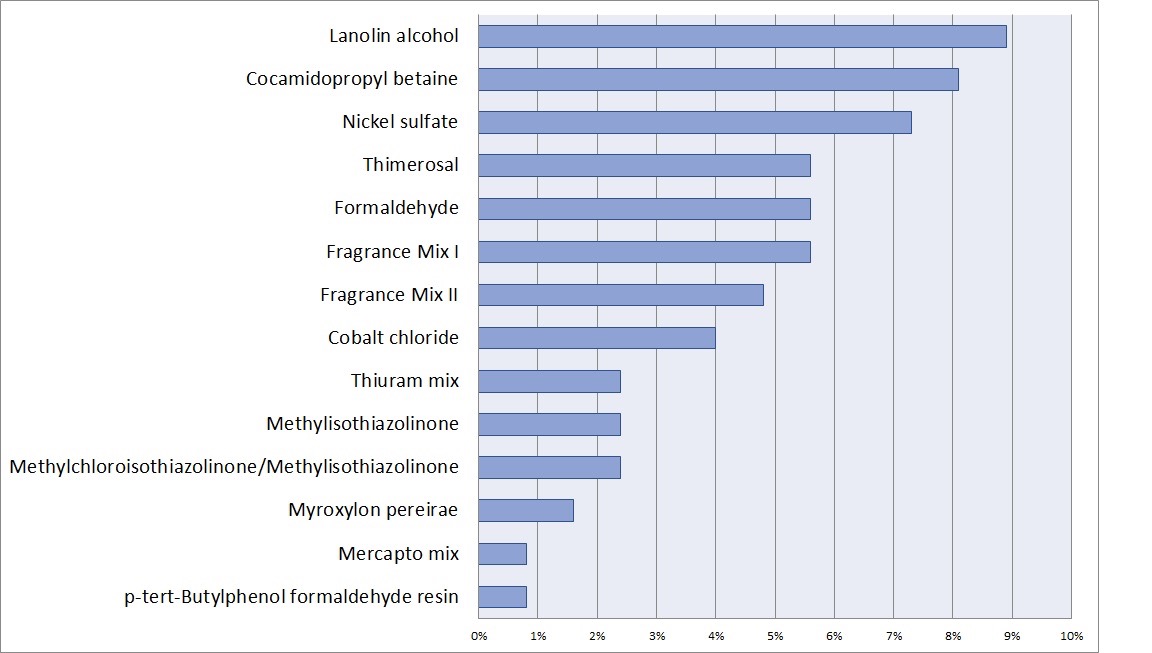Patch Testing of Thai Children with Eczema
DOI:
https://doi.org/10.33192/smj.v75i2.260740Keywords:
Patch test, children, pediatric, eczema, allergic contact dermatitisAbstract
Objective: To detect contact allergy rate and common allergens in Thai children presented with eczema.
Materials and Methods: A total of 124 children, aged 1-15 years, were patch tested using a pediatric screening series of 16 allergens and relevant additional allergens. Data on clinical presentation, atopic history and test results were collected.
Results: Contact allergy was found in 51 of 124 children (41.1%) presented with all forms of eczema. The common allergens were lanolin alcohol (8.9%), cocamidopropyl betaine (8.1%), nickel sulfate (7.3%), fragrance mix I (5.6%), formaldehyde (5.6%), thimerosal (5.6%), fragrance mix II (4.8%), cobalt chloride (4.0%), methylchloroisothiazolinone/methylisothiazolinone (2.4%), methylisothiazolinone (2.4%) and thiuram mix (2.4%). Nineteen of 50 atopic dermatitis patients (38%) showed positive patch test reactions.
Conclusion: Allergic contact dermatitis is common in children. Both atopic and non-atopic patients can develop contact dermatitis. Patch testing should be performed in children presented with eczema regardless of contact dermatitis history.
References
Rodrigues DF, Goulart EM. Patch-test results in children and adolescents: systematic review of a 15-year period. An Bras Dermatol. 2016;91(1):64-72.
Pigatto P, Martelli A, Marsili C, Fiocchi A. Contact dermatitis in children. Ital J Pediatr. 2010;13;36:2.
Kasemsarn P, Boonchai W. Usefulness of Patch Testing in Dermatology. Siriraj Med J. 2012;64(2):73-7.
Moustafa M, Holden CR, Athavale P, Cork MJ, Messenger AG, Gawkrodger DJ. Patch testing is a useful investigation in children with eczema. Contact Dermatitis. 2011;65:208-12.
Rodrigues DF, Goulart EM. Patch test results in children and adolescents. Study from the Santa Casa de Belo Horizonte Dermatology Clinic, Brazil, from 2003 to 2010. An Bras Dermatol. 2015;90(5):671-83.
de Waard-van der Spek FB, Oranje AP. Patch tests in children with suspected allergic contact dermatitis: a prospective study and review of the literature. Dermatology. 2009; 218:119-25.
Simonsen AB, Deleuran M, Johansen JD, Sommerlund M. Contact allergy and allergic contact dermatitis in children - a review of current data. Contact Dermatitis. 2011;65(5):254-65.
Zug KA, Pham AK, Belsito DV, DeKoven JG, DeLeo VA, Fowler Jr JF, et al. Patch testing in children from 2005 to 2012: results from the North American Contact Dermatitis Group. Dermatitis. 2014;25(6):345-55.
Cattani CAS, Oppermann K, Perazzoli S, Guarda NH, Barea P, Bonamigo RR. Sensitizing agents found in children and adolescents with recalcitrant atopic dermatitis: a cross-sectional study with a pediatric battery. An Bras Dermatol. 2022;97(3):307-14.
Mortz CG, Andersen KE. Allergic contact dermatitis in children and adolescents. Contact Dermatitis. 1999;41:121-30.
Boonstra M, Rustemeyer T, Middelkamp-Hup MA. Both children and adult patients with difficult-to-treat atopic dermatitis have high prevalences of concomitant allergic contact dermatitis and are frequently polysensitized. J Eur Acad Dermatol Venereol. 2018;32(9):1554-61.
Boonchai W, Chaiyabutr C, Charoenpipatsin N, Sukakul T. Pediatric contact allergy: A comparative study with adults. Contact Dermatitis. 2021;84(1):34-40.
Silverberg JI, Patel N, Warshaw EM, DeKoven JG, Atwater AR, Belsito DV, et al. Lanolin allergic reactions: North American Contact Dermatitis Group experience, 2001 to 2018. Dermatitis. 2022;33(3):193-99.
Jacob SE, Herro EM, Sullivan K, Matiz C, Eichenfield L, Hamann C. Safety and efficacy evaluation of TRUE TEST panels 1.1, 2.1, and 3.1 in children and adolescents. Dermatitis. 2011;22(4):204-10.
Uldahl A, Engfeldt M, Svedman C. Clinical relevance of positive patch test reactions to lanolin: a ROAT study. Contact Dermatitis. 2021;84(1):41-9.
Jacob SE, Amini S. Cocamidopropyl betaine. Dermatitis. 2008;19(3):157-60.
Belloni Fortina A, Fontana E, Peserico A. Contact sensitization in children: a retrospective study of 2,614 children from a single center. Pediatr Dermatol. 2016;33(4):399-404.
Jacob SE, McGowan M, Silverberg NB, Pelletier JL, Fonacier L, Mousdicas N, et al. Pediatric contact dermatitis registry data on contact allergy in children with atopic dermatitis. JAMA Dermatol. 2017;153(8):765-70.
Mortazavi H, Ehsani A, Sajjadi SS, Aghazadeh N, Arian E. Patch testing in Iranian children with allergic contact dermatitis. BMC Dermatol. 2016;16(1):10.

Published
How to Cite
Issue
Section
Categories
License

This work is licensed under a Creative Commons Attribution-NonCommercial-NoDerivatives 4.0 International License.
Authors who publish with this journal agree to the following conditions:
Copyright Transfer
In submitting a manuscript, the authors acknowledge that the work will become the copyrighted property of Siriraj Medical Journal upon publication.
License
Articles are licensed under a Creative Commons Attribution-NonCommercial-NoDerivatives 4.0 International License (CC BY-NC-ND 4.0). This license allows for the sharing of the work for non-commercial purposes with proper attribution to the authors and the journal. However, it does not permit modifications or the creation of derivative works.
Sharing and Access
Authors are encouraged to share their article on their personal or institutional websites and through other non-commercial platforms. Doing so can increase readership and citations.














